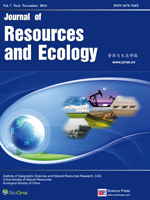Research for changes of soil water and salt is an important content of land sciences and agriculture sciences in arid and semi arid regions. In this paper, sampling in actual agricultural fields, laboratory analysis of soil samples and statistical analysis methods are used to quantitatively analyze soil salinity changes under different irrigation methods throughout the cotton growing season in Shihezi reclamation area. The results show that irrigation methods play an important role in soil salt content in the surface soil (0–20 cm) and sub-deep soil (40–60 cm), followed by deep soil layer (60–100 cm) and root soil layer (20–40 cm). Furrow irrigation yields the maximum soil salt content in deep layer (60–100 cm) or sub-deep layer (40–60 cm) and the maximum salinity occurs in the first half of the cotton growing season (June or earlier). In contrast, drip irrigation yields the maximum soil salinity in the root layer (20–40 cm) or sub-deep (40–60 cm), and this usually appears in the second half growing season (July or after). The ratio of chloride ion to sulfate ion (Cl-/ ) and its change in the soil are on the rise under furrow irrigation, while the value first increased and then decreased with a peak point in June under drip irrigation. This suggests that furrow irrigation may shift the type of soil salinization to chloride ion type moreso than drip irrigation. Potassium and sodium ion contents of the soil show that soil sodium+potassium content will drop after the first rise under furrow irrigation and the value is manifested by fluctuations under drip irrigation. Potassium+sodium content change is relatively more stable in the whole cotton growth period under irrigation methods. The maximum of sodium and potassium content of the soil usually occur in deep soil layer (60–100 cm) or sub-deep soil layer (40–60 cm) in most sample points under furrow irrigation while it is inconsistent in different sample points under drip irrigation. A nonparametric test for paired samples is used to analyze differences of soil salt content under different irrigation methods. This analysis shows that the impact of irrigation on soil salinity is most significant in July, followed by August, June, May, and April in most sample points. The most significant impact of irrigation methods occurs in the surface soil layer (0–20 cm), followed by deep layer (60–100 cm), root layer (20–40 cm) and sub-deep (40–60 cm). These conclusions will be benefitial for mitigation of soil salinization, irrigation and fertilization and sustainable land use.
) and its change in the soil are on the rise under furrow irrigation, while the value first increased and then decreased with a peak point in June under drip irrigation. This suggests that furrow irrigation may shift the type of soil salinization to chloride ion type moreso than drip irrigation. Potassium and sodium ion contents of the soil show that soil sodium+potassium content will drop after the first rise under furrow irrigation and the value is manifested by fluctuations under drip irrigation. Potassium+sodium content change is relatively more stable in the whole cotton growth period under irrigation methods. The maximum of sodium and potassium content of the soil usually occur in deep soil layer (60–100 cm) or sub-deep soil layer (40–60 cm) in most sample points under furrow irrigation while it is inconsistent in different sample points under drip irrigation. A nonparametric test for paired samples is used to analyze differences of soil salt content under different irrigation methods. This analysis shows that the impact of irrigation on soil salinity is most significant in July, followed by August, June, May, and April in most sample points. The most significant impact of irrigation methods occurs in the surface soil layer (0–20 cm), followed by deep layer (60–100 cm), root layer (20–40 cm) and sub-deep (40–60 cm). These conclusions will be benefitial for mitigation of soil salinization, irrigation and fertilization and sustainable land use.
How to translate text using browser tools
1 November 2016
Impact of Irrigation Methods on Soil Salt Content and Their Differences in Whole Cotton Growing Season in Arid Area of Northwest China
Jin Jianjun,
Ran Shenghong,
Liu Taotao
ACCESS THE FULL ARTICLE
arid area of northwest China
cotton growing season
Soil salinity
soil water content





